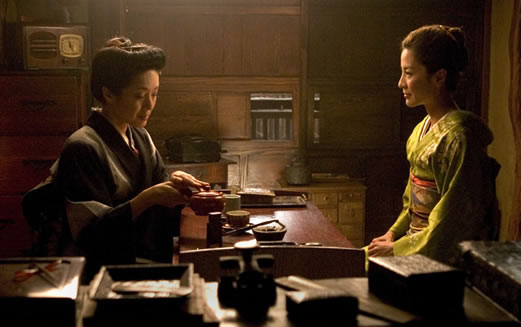The presenter was a little vague about why he personally did not like this particular work, but he did make it clear that "geisha are performers, not prostitutes." Consider my interest piqued. I had very little previous knowledge of geisha—or even of Japan during & after the Meiji period—but neither had I thought to equate them with workers in the sex industry. It was then that I added MoaG to my summer reading list and have since found that it is a well-written story that offers some accurate historical insight into the lifestyle of geisha during the early to mid-1900s despite the fact that it is written from a western perspective.
This is not a book review, though. No matter my feelings about the novel's (albeit somewhat limited) usefulness in the understanding and analysis of a foreign social culture—or indeed the many challenges made to particular 'creative' assertions made by Golden after his work was published—the movie needs to be seen in its own light. My major reason? Memoirs of a Geisha is an American movie, filmed mostly on American soil using Hollywood sets. It was based on an American screenplay which was then shot by an American director and produced by a bunch of, you guessed it: Americans. Also, for whatever reason, the casting crew thought that it was a brilliant idea to have Chinese actresses take on the three lead female roles. Like nobody would notice. 'murica.
Does that mean it is not worth anybody's time to watch? Surprisingly, no.
There are a few differences between the book and the film, as always. For instance, the latter did not go in-depth into Chiyo's childhood, the loss of her virginity/mizuage, or the immediate aftermath of the Baron's molestation. Also, Chiyo's transformation into a full-blown geisha was literally montage'd. Apart from those things (and a lot of skimming through Japanese history and tradition not directly related to geisha), the film did a fairly decent job relating the original story. Still, keep in mind that this is Hollywood, where things are made to look both glitzy and sensational. America is rather odd when it comes to censorship, i.e., violence generally seems to be okay while nudity and sex—the tasteful variety—have been viewed with negative bias until more recent years.
As I just mentioned, certain scenes of a more sexual nature were glossed over completely on-screen. This is definitely not so in the book where geisha like Hatsumomo are made to look promiscuous, and Sayuri is instructed to put her body on offer should she or her onesan deem it necessary. In the movie, Hatsumomo's liaisons with the local lads are made to look a bit more heartwarming ("She loved once. She hoped once.") and Sayuri is shown as a victim of her circumstances—perhaps justly so—rather than as an engaged player. Her written counterpart, however, comes off as being a bit more wise to the world and is less at the mercy of the men in her life due to long-term scheming and subtle emotional manipulation.
As I just mentioned, certain scenes of a more sexual nature were glossed over completely on-screen. This is definitely not so in the book where geisha like Hatsumomo are made to look promiscuous, and Sayuri is instructed to put her body on offer should she or her onesan deem it necessary. In the movie, Hatsumomo's liaisons with the local lads are made to look a bit more heartwarming ("She loved once. She hoped once.") and Sayuri is shown as a victim of her circumstances—perhaps justly so—rather than as an engaged player. Her written counterpart, however, comes off as being a bit more wise to the world and is less at the mercy of the men in her life due to long-term scheming and subtle emotional manipulation.
 |
| Mameha teaching Chiyo/Sayuri a traditional fan dance. |
There is obviously more to the movie than how it differentiates from the novel. It is important to look at the accuracy of both given their popularity, meaning that they "likely shaped western perspectives." Also note, however, that the film especially can be useful as a teaching tool because it reached such a wide audience—likely one much larger than the book's readership. Such works obviously have to be viewed with caution, as they are often confined to showing a single perspective and sometimes have to leave out out important contextual material. All the same, I personally found it helpful to view the film. Coming from the U.S., it was challenging to picture a few things mentioned in the the book, such as time-honoured tea ceremonies, ritualistic dances, foreign musical instruments, et cetera. (This was after I had already taken several courses in Eastern culture throughout my academic career.) Coming equipped to see this film with some background information and a general understanding of the impact of global perspectives, I felt secure in my appreciation of what MoaG had to offer.
 |
| Mother and Mameha discussing business over tea. |
In the end, so long as the audience is armed with some preliminary info. about Japanese culture around the time of WWII and can figure out that one movie does not represent the singular truth (esp. when it is a fictive autobiography), then there is no reason as to why MoaG cannot be an advantageous viewing experience. Unfortunately, the above criteria is not usually taken into account, as it is rare that people go out to the cinema for its historical acuity. Even then, though, MoaG is not so blatantly wrong that viewers going in with absolutely no familiarity with the subject matter would be somehow irrevocably mislead or 'damaged' by watching it. All told, the film features an impactful story with some beautiful choices in direction (dance scene, Imma lookin' at'choo!). It gets a solid recommendation from this viewer.
For further information:

No comments:
Post a Comment
Note: Only a member of this blog may post a comment.